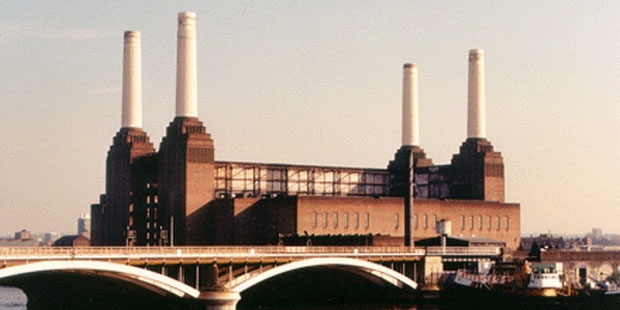Battersea Power Station
The below text is from Wikipedia’s entry for Battersea Power Station
Battersea Power Station is a decommissioned coal-fired power station located on the south bank of the River Thames, in Nine Elms, Battersea, an inner-city district of South West London. It comprises two individual power stations, built in two stages in the form of a single building. Battersea A Power Station was built in the 1930s, with Battersea B Power Station to the east in the 1950s. The two stations were built to a nearly identical design, providing the long-recognised four-chimney layout. The station ceased generating electricity in 1983, but over the past 50 years it has become one of the best known landmarks in London and is Grade II* listed.[1][2] The station’s celebrity owes much to numerous popular culture references, which include the cover art of Pink Floyd‘s 1977 album Animals and its appearance in the 1965 Beatles‘ film Help!
The station is one of the largest brick buildings in the world[3] and is notable for its original, lavish Art Deco interior fittings and decor.[4] The building remained largely unused for more than 30 years after its closure; in 2008 the condition of the structure was described as “very bad” by English Heritage, which included it in its Heritage at Risk Register.[5] The site was also listed on the 2004 World Monuments Watch by the World Monuments Fund.[6]
Since the station’s closure, numerous redevelopment plans were drawn up from successive site owners. In 2004, when a redevelopment project byParkview International stalled, the site was sold to the administrators of Irish company Real Estate Opportunities (REO), who bought it for £400 million in November 2006 with plans to refurbish the station for public use and build 3,400 homes across the site.[7][8] This plan fell through due to REO’s debt being called in by the state-owned banks of the UK and Ireland. The site was again put up for sale in December 2011 through commercial estate agent Knight Frank.[9][10][11] The combination of an existing debt burden of some £750 million, the need to make a £200 million contribution to a proposed extension to the London Underground, requirements to fund conservation of the derelict power station shell, and the presence of a waste transfer station and cement plant on the river frontage made commercial development of the site a significant challenge.[12][13]
In 2012, administrators Ernst & Young entered into an exclusivity agreement with Malaysia’s SP Setia and Sime Darby to develop the site.[14] The £400 million sale was completed in September 2012, and the redevelopment intends to implement the Rafael Vinoly design, which had gained planning consent from Wandsworth Council in 2011.[15] In January 2013, the first residential apartments went on sale.[16] Construction on Phase 1 was due to commence in 2013, with completion due in 2016/17.[17] Apple will locate its new London headquarters at Battersea Power Station, becoming the largest office tenant with 1,400 staff across six floors in the central boiler house.[18]

